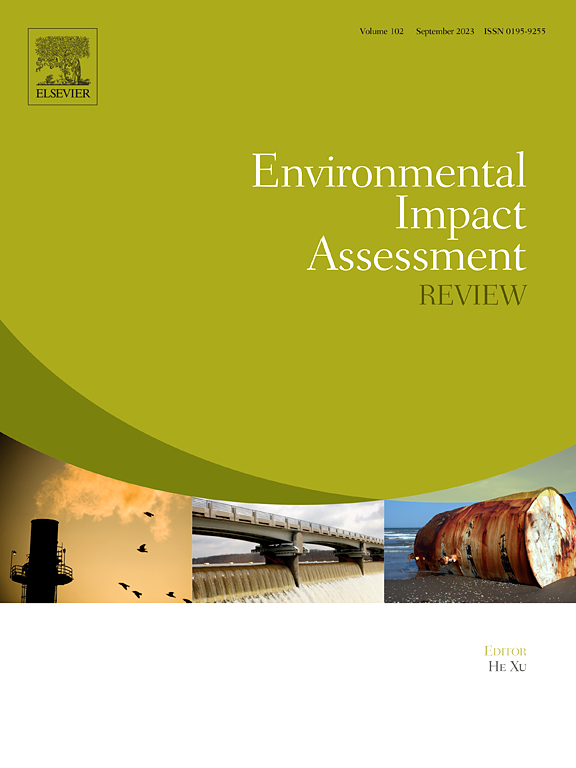Promoting sustainable transition for tea plantations through carbon incentives and offsets: A case study in Pu’er, Yunnan Province, China
IF 9.8
1区 社会学
Q1 ENVIRONMENTAL STUDIES
引用次数: 0
Abstract
Tea is one of the most popular beverages worldwide. The transition to sustainable tea production is of paramount importance for the industry. This study assessed the carbon footprint of tea production in the Pu’er region, China, by integrating carbon sequestration and emissions using a “cradle-to-gate” lifecycle concept. Furthermore, a dualtier emission reduction simulations combining six measures and four scenarios was conducted to develop carbon offset and incentive standards for tea plantations based on their emission intensity. The results indicated that organic tea plantations had an average carbon emission of 1.24 t CO2 eq ha−1, while conventionally managed tea plantations had an average of 3.96 t CO2 eq ha−1. The carbon emissions of conventionally managed tea plantations exhibited considerable variability, and through cluster analysis, were categorized into high, medium, and low emission intensities. Compared with conventionally managed tea plantations of high, medium, and low intensities, organic tea exhibited significant reductions in carbon emissions of 76.92 %, 69.48 %, and 57.11 %, respectively, while increasing carbon sequestration by 25.33 %, 11.52 %, and 25.36 %, respectively. An integrated program of improved fertilizer management, optimized agricultural practices, and strengthened policy guidance resulted in a reduction of carbon emissions from conventional tea plantations by 48.02 %, 44.97 %, and 55.92 %, respectively, while the net carbon sink of organic tea plantations increased by 22.36 %. Various carbon incentive and offset standards scenarios were developed based on the emission intensities. The carbon incentives for conventional tea plantations ranged from 0.38 to 6.49 USD ha−1 for single scenarios and 2.26 to 10.11 USD ha−1 for combined scenarios, respectively. Carbon offsets for organic tea plantations ranged from 11.31 to 13.69 USD ha−1 for combined scenarios. This study underscores the necessity for novel carbon management strategies in tea production and the significance of carbon offsets and incentives for low-carbon transformation of tea cultivation. This study is a valuable reference for other agricultural sectors pursuing sustainability and climate resilience.

通过碳激励和抵消促进茶园的可持续转型:以云南省普洱为例
茶是全世界最受欢迎的饮料之一。向可持续茶叶生产的过渡对茶叶行业至关重要。本研究采用“从摇篮到大门”的生命周期概念,通过整合碳封存和排放,评估了中国普洱地区茶叶生产的碳足迹。在此基础上,通过六种措施和四种情景的双层减排模拟,建立了基于排放强度的茶园碳补偿和激励标准。结果表明,有机茶园的平均碳排放量为1.24 t CO2 eq ha−1,而常规茶园的平均碳排放量为3.96 t CO2 eq ha−1。传统管理茶园的碳排放表现出较大的变异性,通过聚类分析将其划分为高、中、低排放强度。与常规管理的高、中、低强度茶园相比,有机茶的碳排放量分别减少了76.92%、69.48%和57.11%,固碳量分别增加了25.33%、11.52%和25.36%。通过改善肥料管理、优化农业实践和加强政策引导等综合措施,常规茶园碳排放量分别减少48.02%、44.97%和55.92%,而有机茶园的净碳汇增加22.36%。根据排放强度制定了各种碳激励和抵消标准方案。传统茶园的碳激励在单一情景下为0.38 - 6.49美元,在综合情景下为2.26 - 10.11美元。在综合情景下,有机茶园的碳补偿范围为11.31 ~ 13.69 USD ha - 1。本研究强调了茶叶生产中新型碳管理策略的必要性,以及碳抵消和激励对茶叶种植低碳转型的重要性。本研究对其他追求可持续发展和气候适应能力的农业部门具有重要的参考价值。
本文章由计算机程序翻译,如有差异,请以英文原文为准。
求助全文
约1分钟内获得全文
求助全文
来源期刊

Environmental Impact Assessment Review
ENVIRONMENTAL STUDIES-
CiteScore
12.60
自引率
10.10%
发文量
200
审稿时长
33 days
期刊介绍:
Environmental Impact Assessment Review is an interdisciplinary journal that serves a global audience of practitioners, policymakers, and academics involved in assessing the environmental impact of policies, projects, processes, and products. The journal focuses on innovative theory and practice in environmental impact assessment (EIA). Papers are expected to present innovative ideas, be topical, and coherent. The journal emphasizes concepts, methods, techniques, approaches, and systems related to EIA theory and practice.
 求助内容:
求助内容: 应助结果提醒方式:
应助结果提醒方式:


